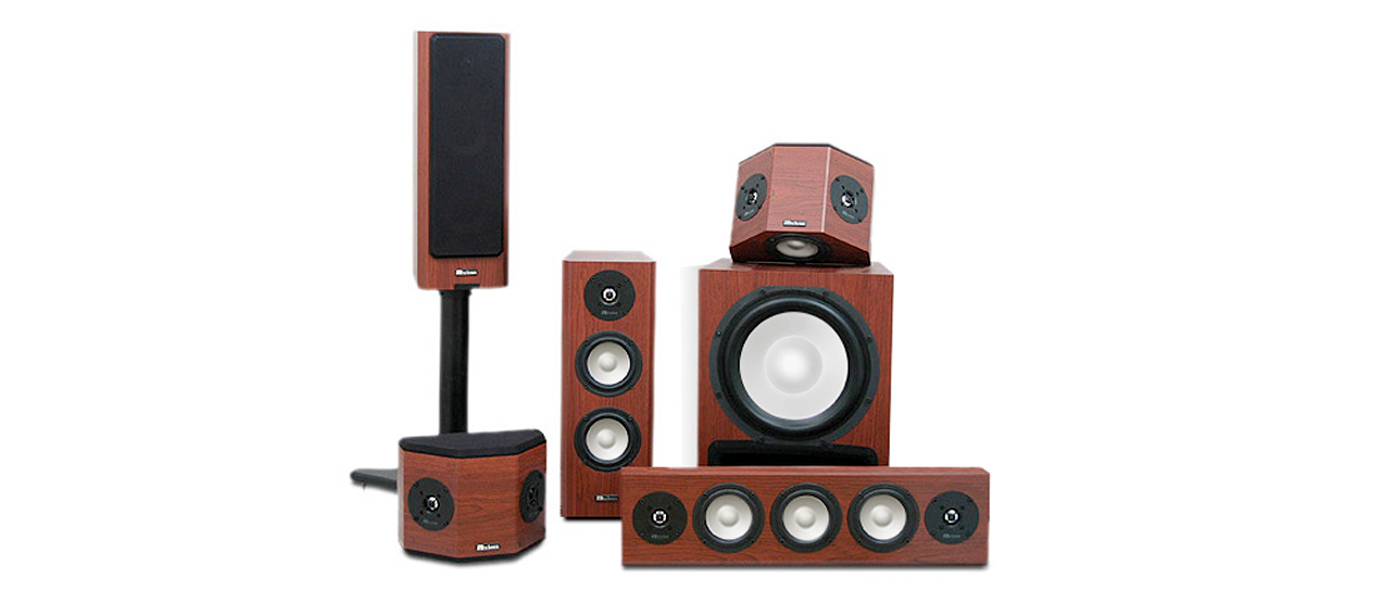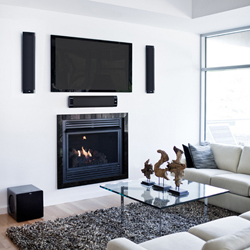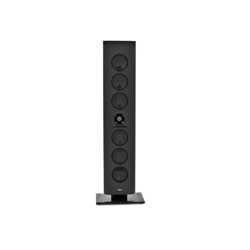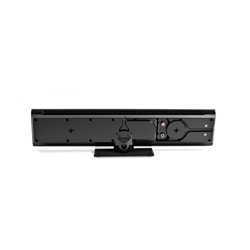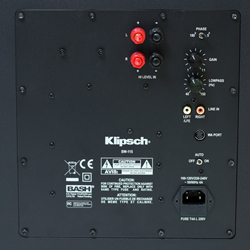Introduction to the Klipsch Gallery G-28 Speaker System
The Klipsch name has been present in the speaker industry since the second World War. Started in Hope Arkansas, Founder Paul Klipsch devoted much of his life’s work to the improvement of horn-loaded tweeters and integration of them into audiophile speaker enclosures.
“An unquestionable success, the Klipschorn®, patented in 1945, is still considered by many to be the finest loudspeaker ever made and is the only speaker in the world that has been in continuous production for over 60 years. ” – Klipsch.com
Use in movie theaters, live music venues, recording studios, and countless home theaters…the Klipsch name has truly become a household item in the world of high end audio.
KLIPSCH GALLERY G-28 SPEAKER SYSTEM SPECIFICATIONS
- Design: Home Theater Speakers, including Subwoofer
- Drivers: One 1″ Titanium Compression Tweeter mated with Square Tractrix Horn, Two 3.5″ Cone Woofers
- MFR: 55 Hz – 24 kHz, ± 3 dB
- Crossover Frequency: 2.2 kHz
- Sensitivity: 94 dB/2.83 V/Meter
- Nominal Impedance: 8 Ohms
- Power Handling: 75 Watts
- Dimensions: 28.5″ H x 6″ W x 2.4″ D
- Weight: 4 Pounds/each
- Msrp: $2,095
- Klipsch
- Secrets Tags: Speakers, Klipsch, Home Theater
The Klipsch Gallery G-28 Speaker System Setup and In Use
Unboxing the system was fairly typical. The speakers were lodged securely into Styrofoam with the speaker grilles separate. Its’ important to note that you’ll want to attach the grilles to the speaker before attaching the mount horizontally as it makes for a tight enough fit that ripping the grille became a concern. The grille cloth is sewn to a magnetic metal rod that attaches around behind the speaker on both sides and I had to loosen the bracket enough for the grille to slide past the speaker-bracket space.
Horn loaded tweeters have long been associated with having a bit more “edge” than traditional soft dome tweeters. Compared to my Paradigm Studio system, this is true. Klipsch has come a long way in overcoming the traditional sound of the earlier horn-loaded tweeter designs, and now their top of the line offerings are almost completely free of it (though the G-28’s limited frequency response allows the listener to still hear it to some degree) It should be noted that users with the ideal setup can mitigate this aspect to a large degree by having carpeted floors, lots of upholstered furniture and by choosing electronics that have a more laid back sound. My living room is ideal for the Klipsch speakers as it has all of these features.
The horn type speakers also have two main advantages over traditional speakers. First, they can play at very loud volumes with minimal distortion due to their relatively very high efficiency of drivers. Second, they are a very easy load to drive and therefore can be used with very moderately priced electronics (read; inexpensive home theater receivers). I won’t say that inexpensive amplification would be wasted, it just won’t pay quite the dividends in horns that it will in non-horn designs.
They can also be advantageous if you want to fill a very large space (such as a large theater) with ear splitting volume and have a limited budget as you can have the same output level with fewer speakers that are driven by modest amplifiers. I would also say that a horn type setup will favor those who will mostly watch movies and less to those looking for a mostly music setup.
After performing a frequency response sweep I found that the G-28’s are comfortably crossed over at 110-120 hz, though in many setups 80 hz is necessary to delocalize the sub. Through experimentation I found that 100Hz can be used at the expense of more thinness in the male vocal region…not a good tradeoff and not a compromise that I prefer to have to make.
I listened to my usual list of music favoring vocals, acoustic guitar, stringed instruments and piano.
On Joss Stone’s “Dirty Man” from The Soul Sessions, the G28 did not bring out the true emotion of the song that I’ve come to expect from my Paradigm Studio 20 monitors. The playback of this song was clean enough but it lacked smoothness in the vocals and air.
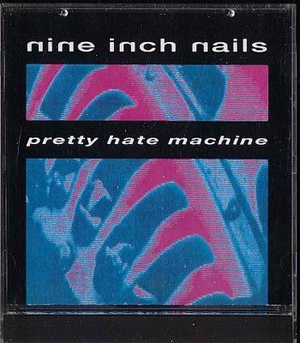
The only music I found performed consistently better on the Gallery system was music that demands to be played at ear bleeding levels. I summoned Mr. Reznor’s Pretty Hate Machine album for this task. “Terrible Lie” was the first song played. After the first 31 seconds the song really opens up and the speakers were up to the task. The go from dead quiet to full throttle instantly and created all the ambience I’ve come to expect from this recording.
The slower, quieter “Something I can Never Have” and “The Only Time” were less impressive due to its lack of dynamic swings, but getting back on track with “That’s What I Get” gets the dynamic sound going again and the Klipsch’s handled every cacophonous hit I threw at it with ease. In fact, the louder the sound the better as NIN uses shattering glass and metal scraping against metal sound effects in their mix and the G-28’s handled this with vigor. The best sounding music from my collection was easily rock. Offerings from Led Zepplin, AC/DC, Metallica were played with gusto, but they also require much less precision to really sound believable that the other kinds of music from my collection.cc
After listening to this setup for a few months I decided to swap in my reference sub, a Velodyne Mini-Vee 10 (largest of the Mini-Vees), to see if there would be a noticeable difference. While the Klipsch sub is not ported, per se, its woofer is “coupled” to other passive drivers which helps bass extension. Indeed, the Klipsch sub bested the Velodyne down low by maybe 5 Hz (I was able to get good response from the Klipsch down to 20 Hz and 25 from the Velodyne, hardly a slouch).
This isn’t the end of the story however. My room setup forced me to place the sub outside well outside the left and right front speakers, causing a bit of disconnect between bass and midrange and allowing the user to tell instantly that the bass wasn’t coming from the same place as the main speakers. This is quite distracting to some.
After swapping in the Velodyne Mini Vee 10 and recalibrating, the entire speaker frequency response was much smoother and bass seemed to come from everywhere due to the Velodyne’s completely sealed design. (it also has a flatter “curve” in its frequency response) The sealed sub seemed to give the G-28’s back their illusion of creating a massive amount of full-bodied sound.
Users that can place the sub in between the left and right front speakers shouldn’t have this problem. I would really like to see an improved version of this speaker with increased cabinet volume (either width, depth or both) to give it a little more upper mid-bass so its easier to integrate with a wider variety of subs, as I believe that this sub is going to be a hard sell at this price and many will opt to keep their old subwoofer and mate it to these L/C/R’s. This would allow a higher crossover frequency which would help to further “hide” the sub’s location.
Conclusions about the Klipsch Gallery G-28 Speaker System
The Gallery faces a great deal of tough competition, many of which are cheaper and this relatively low value proposition represents the most limiting element of the Gallery series. For $500, any number of excellent speakers are available from a large number of manufacturers and most will do a better job in music reproduction. This system would be fine for someone wanted a nice 5.1 only system but the façade crumbles pretty quickly for audio purists looking for a dual music and home theater rig. This setup would be perfect for listeners that are interested only in movies and mostly at high volume in a medium sized room or smaller, but the price needs to come down considerably to be in direct competition with its peers.


